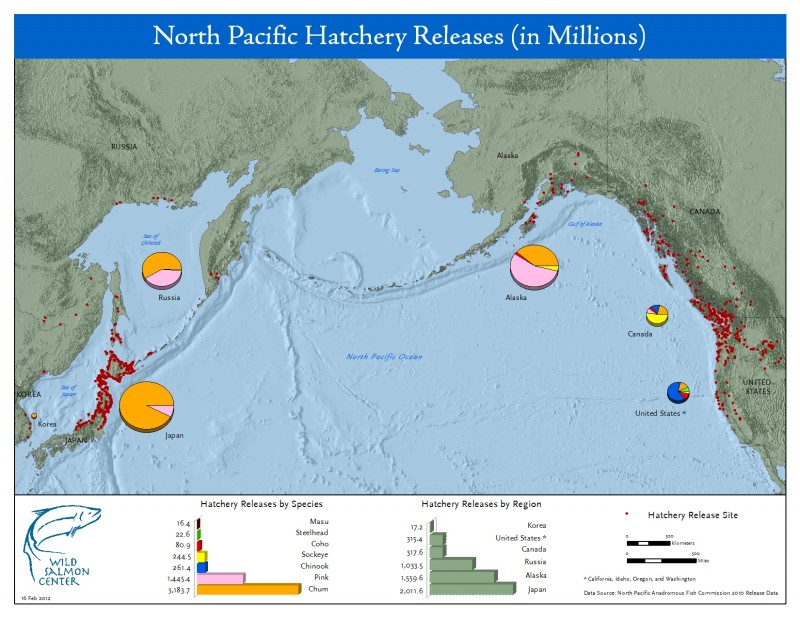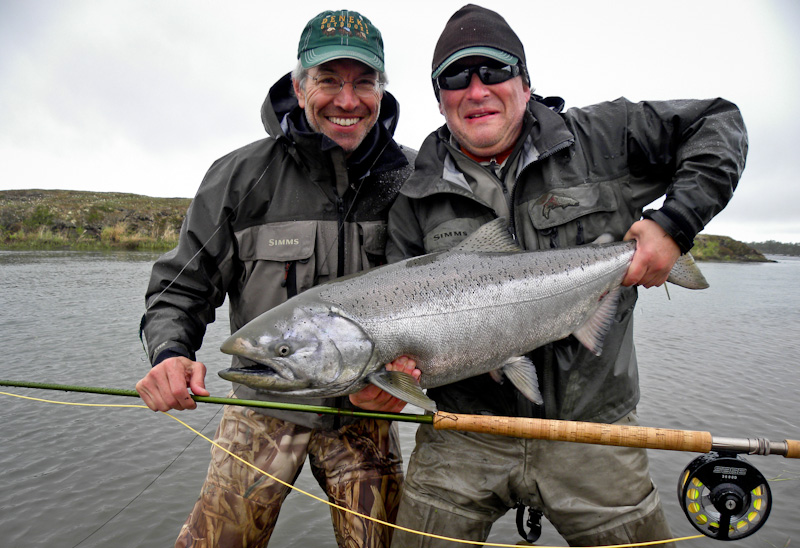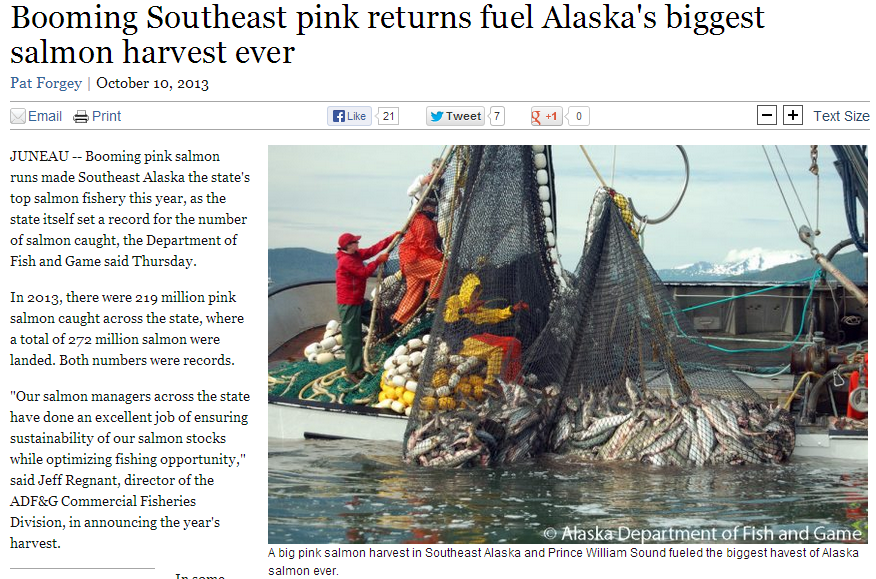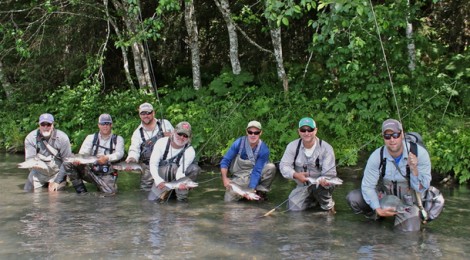
State Of Alaska Declares Emergency: Chinook Salmon Starving At Sea
“It’s NOT the fresh water production of the juvenile Chinook that is the reason this decline is occurring, it’s being driven by poor marine survival,” said Ed Jones, Alaska Dept. of Fish and Game.
The governments answer to this dilemma is not unexpected, tragic but not unexpected. Another 5 yr. study costing tens of millions of dollars employing more than 100 biologists that will study chinook in 12 major river systems from SE Alaska to the Yukon.
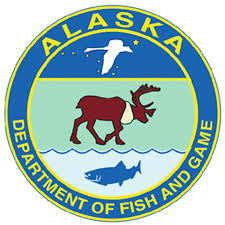 That’s right after declaring the crisis is Chinook salmon starving at sea, the official response is to do another five years of research on Chinook in the fresh water. Give that study another few years after it is completed for the official report, followed by political discussion and debate, and we might just see a work to restore and replenish Alaska’s Chinook salmon in about 10 years.
That’s right after declaring the crisis is Chinook salmon starving at sea, the official response is to do another five years of research on Chinook in the fresh water. Give that study another few years after it is completed for the official report, followed by political discussion and debate, and we might just see a work to restore and replenish Alaska’s Chinook salmon in about 10 years.
The announcement of the new five-year study which adds $30 million to the annual $14 million the state provides for Chinook research includes the statement, ‘while it will be years before the project in the 12 rivers yields definitive data, the science team say they have pinned down early findings that the problem is not in the fresh water but rather has to do with the chinook salmon starving at sea.’
Alaska pays nearly $300 ($289) million per year in wages alone 5,000 workers in fisheries management and operations of fish hatcheries. The state lists the estimated output value of that work at $653 million. The state fishing industry at large is reported to return more than $15 billion each year of which salmon account for more than a third of that total. Salmon is a vital and valuable industry for Alaska.
Jones states, “We don’t know why, but once these juvenile Chinook salmon are entering the ocean they are not surviving at the rates they once did. And at the same, we also are seeing younger and smaller Chinook returning to spawn and this obviously results in smaller fish being caught.”
Chinook salmon spend up to five years in the ocean and production goes through up and down cycles. A few years ago, west coast and British Columbia stocks were said to be doomed but last year and this year the numbers seem to have rebounded somewhat. Perhaps instead of mostly starving at sea they found their ocean pasture was providing something to eat.
Today in Alaska as is the case up and down the Pacific coast salmon science is virtually exclusively fresh water biology and counting what comes back in the catch when the fish return to fresh water. Keep in mind that Chinook/King salmon put on just 2% of their body weight in fresh water and 98% out on their ocean pastures.
How does it make sense to have this exclusive focus on the 2% of their freshwater life to the exclusion of the 98% of their life cycle on their ocean pastures. It just doesn’t make sense, save for the program being a job security program for the status quo in salmon management. With everyone in agreement that Chinook salmon starving at sea is the problem the focus must turn there.
This focus on the fresh water biology of salmon is so overwhelming that legions of freshwater biologists are employed to catch salmon in rivers and streams and study them. It’s a sweet job, “gone fishin” during the week and then goin fishin again on your time off on the weekends. I know this well as some 30 years ago I was one of those fly-fishing fish researchers in government.
The grandest trough of all Pacific salmon fresh-water science is the $700 million dollars per year that is spent by US taxpayers and Bonneville Power Administration rate payers who buy electricity from the dams of the Columbia River. Let’s examine this massive spending.
This year a record number of Columbia River salmon are arriving, that number will be fewer than 5 million fish in total. About 1/5 of those fish, 1 million, are allowed by regulators to be caught which means the subsidy on each salmon caught is $700, yes that is seven hundred dollars per fish caught. In ordinary years the number of fish returning is half this number and a much smaller percentage are allowed to be caught, hence the subsidy per fish is way higher.
There is a better way to bring back the fish! The means to do this is by restoring and replenishing their ocean pastures.
IT JUST WORKS!
One problem ocean pasture restoration faces is that legions of fresh water salmon biologists control every aspect of salmon science. Those fresh water salmon biologists are virtually every one ‘sport fishermen’ who are living the life of Riley with good paying jobs chasing the fish they love to catch.
So with the announcement of more millions to be spent on more in-stream salmon science not a penny is to be spent on the salmon ocean pasture crisis that the salmon boffins have pronounced is the key problem. This is made even more poignant as the cost of restoring the critical Alaska Chinook salmon pastures is a tiny fraction of what will be spent on this additional in-stream work.
I have proven in my 2012 salmon pasture restoration in the Gulf of Alaska that targeted Pinks and Sockeye from SE Alaska and territories south that this kind of restoration effort returns salmon to all time historic abundance immediately.
The increase in Pink salmon along the Pacific coast that was served by our ocean pasture restoration of 2012 increased Pink salmon numbers from an expected 150 million fish to more than 650 million. Sockeye in the Fraser River increased from last years 2 million fish to this years more than 40 million fish.
Bring Back The Fish NOW!
Alaska Chinook can be returned to historic abundance in just 3-5 years at a fraction of the cost of more in-stream salmon science. Alaska Chinook ocean pastures can be restored and replenished immediately with profound results of bringing Chinook back to historic abundance. We are independently working toward that goal as our new Ocean Pastures Corp. Alaska begins work in 2015, stay tuned.
But of course that would shift the focus of salmon science to where it is most needed and most inexpensive and that will not serve the need of the salmon science guilds who will fight to the last to defend their public feeding troughs. Solving environmental problems has never been intended to be a job security plan for those at the public trough.
Answer to suggestion that the Pacific Decadal Oscillation is responsible for “our restored ocean pasture” salmon abundance.
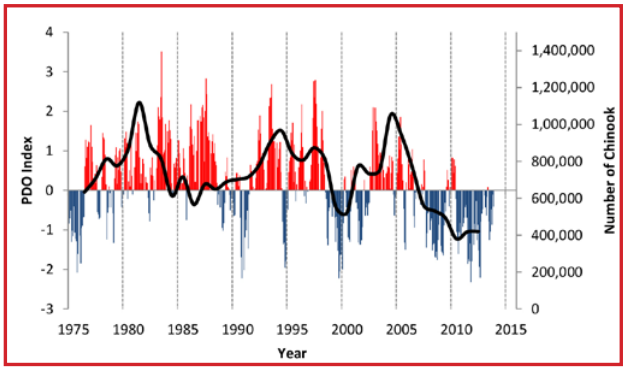
Chart of Pacific Decadal Osscillation (PDO) and Chinook Salmon Decline. Present decadally cooler waters are not seen to be growing chinooks! From State of Alaska Chinook Newsletter Summer 2014









